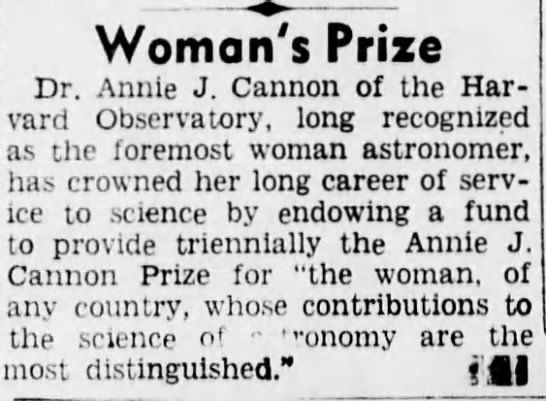Astronomer Annie Jump Cannon was born #OTD in 1863. She was a pioneer of stellar classification and co-creator of the Harvard Classification Scheme. Over her lifetime she *manually* classified around 350,000 stars.
Image: Harvard University, Radcliffe Archives
Image: Harvard University, Radcliffe Archives
Cannon expanded on the classification used by Edward Pickering (director of the Harvard Observatory) and Williamina Fleming, adding the O, B, A, F, G, K, M spectral classes. The Harvard Classification system, adopted by the International Astronomical Union in 1922, is still used.
Annie Jump Cannon learned the basics of astronomy from her mother Mary, who taught her to recognize constellations. Together they built a little observatory in the attic of their home.
Her father encouraged her to attend a new college for women in Massachusetts –– Wellesley. She liked the school but not the weather. She was often sick during her first year there. These illnesses may have contributed to the eventual loss of her hearing.
At Wellesley she studied Physics and Astronomy, working with Sarah Frances Whiting.
https://en.wikipedia.org/wiki/Sarah_Frances_Whiting
https://en.wikipedia.org/wiki/Sarah_Frances_Whiting
Cannon excelled and graduated in 1884 as the valedictorian of her class. But she didn't pursue a career in science. Instead, she moved home to Delaware and led an active social life.
In 1892, after traveling through Europe and publishing a collection of her photography, Cannon contracted scarlet fever and soon lost her hearing. Then in 1894 her mother died.
Annie and her mother had been very close. She decided she had to leave Delaware, so she wrote to Whiting who offered her a position as a physics instructor at Wellesley. Cannon returned to Massachusetts and enrolled at Radcliffe for graduate study in physics and astronomy.
She began to work at the Harvard observatory under the direction of Edward Pickering, and was surprised to find several other women working there.
(Pickering often said that he employed women at the observatory because they were more patient and attentive to detail, and better at working with delicate equipment because of their "small hands." But he was also quick to note that he could pay them a quarter of a man's salary.)
Pickering put Cannon to work classifying stars according to their spectra. He had a ten year backlog of spectrograms that needed to be sorted according to the system he had developed with Williamina Fleming. https://twitter.com/mcnees/status/1261300565272862720
But there was a disagreement over how exactly the stars should be classified, with Antonia Maury advocating for a more complex system than the simple scheme used by Fleming. https://twitter.com/mcnees/status/1241368190111879168
Annie Jump Cannon proposed a third system, a refinement of the Fleming-Pickering system that gathered stars into seven groups –– O, B, A, F, G, K, M –– according to the strength of the Balmer lines in their spectra.
Later, Cecelia Payne would show that the OBAFGKM classification corresponds to descending temperature, with type O stars the hottest and type M the coolest. https://twitter.com/mcnees/status/1259477751603625986
There is a well known but sexist mnemonic for remembering the OBAFGKM classification. What I would like is to hear your proposals for an alternate mnemonic. Please leave them in the replies.
Anyway, Cannon's classification system was rapidly adopted by astronomers. In 1922 the International Astronomical Union passed a resolution formally adopting the system, which is still (with some modifications) in use today.
Annie Jump Cannon was known for her ability to quickly classify stars. Edward Pickering said "Miss Cannon is the only person in the world — man or woman — who can do this work so quickly."
There are stories of her classifying a star in as little 3 seconds. This newspaper article from 1913 describes her working at a rate of 200 per hour.
https://www.newspapers.com/clip/10248290/the-danville-morning-news/
https://www.newspapers.com/clip/10248290/the-danville-morning-news/
During her career, Annie Jump Cannon classified about 350,00 stars.
350,000.
That's a lot of stars to manually classify.
If you could classify one star per minute nonstop for 8 hours per day, 7 days per week, it would take you two full years to classify 350,000 stars.
If you could classify one star per minute nonstop for 8 hours per day, 7 days per week, it would take you two full years to classify 350,000 stars.
Cannon received numerous awards and honors throughout her career. In 1932 she won the Ellen Richards prize from the Association to Aid Scientific Research by Woman, and used the prize money to endow an award of her own: The Annie Jump Cannon Prize.
Image: The Brooklyn Eagle
Image: The Brooklyn Eagle
The Annie Jump Cannon Prize was initially awarded every three years. Starting in 1974 it was awarded every two years, and since 1988 the prize has been awarded annually.
https://aas.org/grants-and-prizes/annie-jump-cannon-award-astronomy
https://aas.org/grants-and-prizes/annie-jump-cannon-award-astronomy
Annie Jump Cannon retired in 1940, and passed away in 1941.
Here is a "Wonder Woman of History" profile of Annie Jump Cannon from a 1949 issue of the the Wonder Woman comic book.
Credits: Julius Schwartz (writer), Paul Reinman (pencils), Bernard Sachs (inks)
Credits: Julius Schwartz (writer), Paul Reinman (pencils), Bernard Sachs (inks)

 Read on Twitter
Read on Twitter










